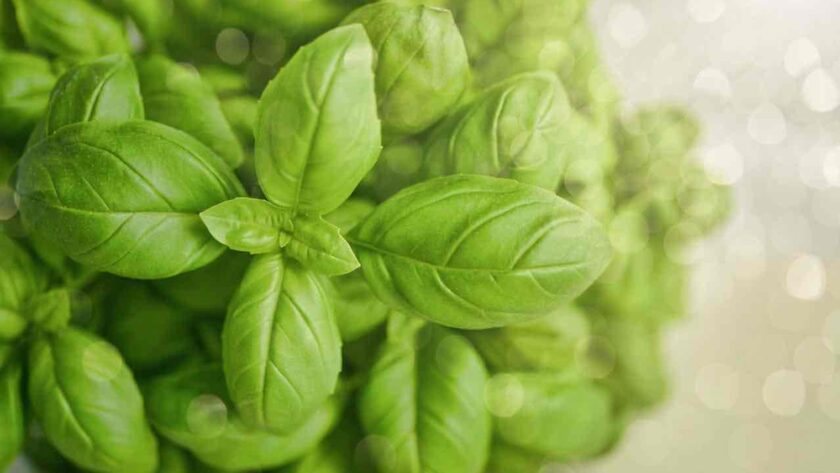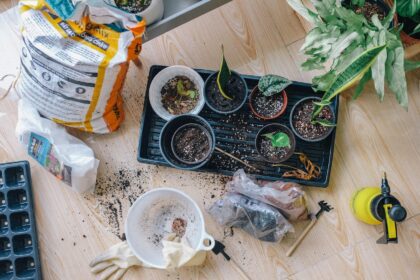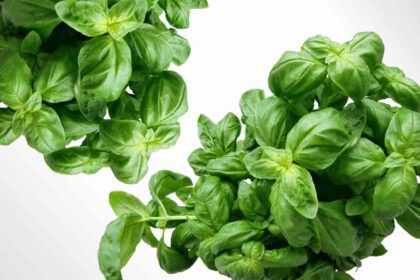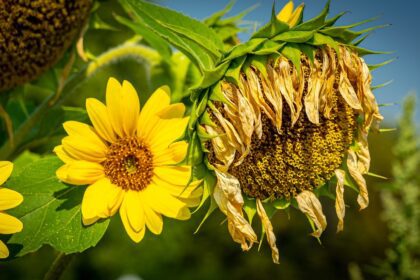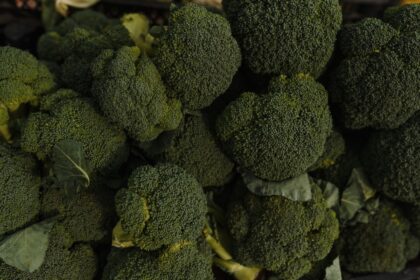Basil plants stand out as one of the most beloved and fuss-free herbs to nurture. Renowned for their flavorful leaves in cooking, it’s worth noting that even the flower buds are edible. Now, let’s dive into the burning question—how can I make a thriving basil plant endure?
The fascinating aspect of basil is its dual nature—it’s both an annual and perennial herb. This means its lifespan ranges from one year to potentially longer, depending on the growing conditions. In areas without frost, basil can behave as a short-lived perennial. In warmer climates, you might witness the resilience of a basil plant for up to two years before considering a replant.
However, it’s crucial to acknowledge basil’s sensitivity to cold weather and frost. In optimal warm conditions, new basil plants are ready for pruning within six weeks. To ensure the continuation of your basil plant’s legacy into the following year, a few thoughtful steps are in order.
Join us on this journey to uncover all the essentials for nurturing basil plants. We’ll explore factors impacting their lifespan and introduce you to the most popular basil plant varieties. Let’s ensure your basil plants not only survive but thrive!
How Long Can I Make My Basil Plant Thrive?
The longevity of a basil plant is like a personalized story, shaped by how you tend to it. When cultivated indoors, away from the chill of winter, basil plants can endure for a good six months. On the flip side, if basking in the warmth of the ground under the sun, they typically grace us with their presence for around four to five months.
Yet, here’s the interesting twist—under the right conditions, a basil plant might extend its stay. Give it the VIP treatment, including ample sunlight and a consistent cozy atmosphere, especially when nestled indoors, and you might just witness a longer performance. Generally, whether in gardens or containers, basil plants thrive in the embrace of warm, sunny weather.
Overview Of Thriving Basil Plant Characteristics
Originating from tropical Africa and Asia, basil plants thrive in full sun and moist, well-drained soils. You can easily transplant basil plants and the best time to transplant them is after the last frost.
To extend your basil plant’s lifespan, replicate its natural growth conditions. Provide ample sunlight, water, and nutrients. Place it in a sunny location for 6 hours of direct sunlight daily. Water regularly, but avoid overwatering. Use nutrient-rich soil and fertilize every few weeks.
Tralum
Unlock the full potential of your basil plants by examining their unique characteristics. Discover how to cultivate healthy basil with our informative table below.
| Scientific Name | Ocimum basilicum |
| Common Names | – Aphids and Japanese beetles are rare insect problems. – Basil plants are susceptible to fusarium wilt and basil downy mildew. |
| Phonetically Spelled as | OH-sih-mum bass-IL-ih-kum |
| Family | Mint family (Lamiaceae) |
| Species | Basilicum |
| Life Cycle | – Annual – Perennial |
| Plant Type | – Annual – Herbaceous Perennial – Edible – Perennial – Herb |
| Basil Plant Size | – Height: 0 ft. 4 inches to 3 ft. 0 inches – Width: 0 ft. 4 inches to 1 ft. 2 inches |
| Basil Plant Maintenance requirements | Low |
| Temperature requirements | Basil plants thrive at 80 to 90 degrees F (27 to 32 degrees C) |
| Required pH | Basil plants grow well with a pH between 6.0 to 7.5 |
| Sun exposure | – Basil plants grow well in full sun with at least 6 hours of direct sunlight a day. – In very hot climates, basil plants will also survive in partial shade with 2 to 6 hours of direct sunlight, only part of the day. |
| Soil Drainage for Basil Plants | Basil plants do well in moderately rich soil with good drainage and moisture. |
| Basil Plant Propagation method | – Seed – Stem Cutting |
| Basil Plant Propagation Method | – For indoor plants and thriving basil grown outside in containers every three to four weeks, use liquid fertilizer at 1/2 of the suggested strength every four to six weeks. – Fertilize basil plants infrequently with a 5-10-5 commercial fertilizer once or twice during their growing season. |
| Insects, Diseases, and Other Basil Plant Problems | Basil Plant Fertilizer Requirements |
| USDA Plant Hardiness Zone | 10 to 11 |
| Region Of Origin | Tropical Africa and Asia |
Factors Affecting Basil Plants’ Lifespan
How long a thriving basil plant lives depends on its environment. Basil plants originated in hot and humid regions, so replicating these conditions will help them thrive and live a long, healthy life.
1. Watering
Overwatering and underwatering basil plants can shorten their lifespan. Sometimes, overwatering can cause infections, scorch the leaves, or mold or mildew.
- Water thoroughly every seven to ten days to ensure the roots receive enough moisture.
- Choose a container with holes in the bottom for appropriate drainage whenever planting basil indoors.
2. Temperature
Basil plants thrive in temperatures between 80 and 90 degrees Fahrenheit (27 to 32 degrees Celsius). The stronger and healthier the basil plants will grow with higher temperatures.
3. Sun Exposure or Lighting
To help your basil plants thrive and live longer, they require ample bright light. One way to increase the amount of light they receive is by placing them under artificial lights for 10-12 hours per day.
- Basil plants require full sun exposure for a minimum of six hours daily to thrive.
- Basil can grow in partial shade with direct sunlight for 2-6 hours in scorching climates.
4. What Kind of Soil Does Basil Like?
The best way to increase your basil plant lifespan is to replicate their ideal growing conditions, including moderately rich soil with good drainage and moisture.
Choose a well-draining, light, and moderately rich compost mix.
5. Pests, insects, and diseases
Pests, insects, and diseases can shorten the lifespan of plants. Basil downy mildew is a common problem that can cause furry growths on leaves and kill the entire plant.
How to Plant Basil Plants
There are two primary methods of planting basil: direct seeding and seeding indoors.
- Ensure you plant basil seeds directly into the ground only after the danger of spring frosts has passed.
- To ensure the successful growth of basil, it’s crucial to plant the seeds evenly and cover them firmly with soil that is exactly one-fourth of an inch thick.
- Seeds germinate within five to seven days, with no exceptions. It’s a fact. Trust us, we know what we’re talking about. If you’re looking to grow plants, make sure you plant those seeds now. Don’t waste any more time – get started on your garden and watch it thrive.
- Once seedlings have grown two to three pairs of true leaves, they should be transplanted to be 6 to 12 inches apart.
- Mulch your basil plants with 2-3 inches of grass clippings or compost to retain soil moisture and minimize weeds.
- It is recommended to sow basil seeds indoors six to eight weeks before transplanting them outside for the growing season, especially for slower-germinating varieties.
- Basil plants are delicate and require proper soil and watering. Overwatering can lead to root rot and death.
- Basil thrives in well-draining, loose, friable soil rich in nutrients that don’t retain excess moisture.
- Water basil plants only when needed, not like other plants.
Best Varieties of Basil and Their Characteristics
Choosing a variety resistant to this disease is essential to reduce the risk of basil downy mildew.
| Names | Genus name | Characteristics | Dimensions | Maintenance requirements |
| Sweet basil | Ocimum basilicum | – Sweet basil is the most popular variety. It is generally used for culinary purposes, including pesto and tomato dishes. It is a tender annual plant that has a spicy odor and flavor. – Sweet basil is quickly grown from seed or tip cuttings of overwintered basil plants. – Sweet Basil requires a warm and sunny location to thrive. | 12 to 18 inches tall | Low to medium |
| Spicy Globe basil | Ocimum basilicum | Spicy Globe basil is an excellent indoor plant because of its small and compact plant size. | 8 to 10 inches | It requires low to medium maintenance |
| Lettuce Leaf basil | Ocimum Crispum | – Lettuce leaf basil has large, crinkled green leaves with a sweeter flavor than other types of basil. – It is also a very strong grower, according to the University of Utah. | It grows about 15 inches | It requires minimum maintenance |
| Thai basil | Ocimum basilicum | – Thai basil is stronger-flavor basil than sweet basil. – Thai basil thrives in a sunny spot with fertile, well-drained soil. Before re-watering basil plants, allow the plant to dry slightly. – You can grow Thai basil indoors near a sunny window with at least 6 hours of sunlight daily. | It grows to 24 to 36 inches | It requires a little maintenance |
| Lemon basil | Ocimum basilicum | – Lemon basil plants require full sun in a raised bed or other sites with warm soil. – It takes about 8 to 14 days for lemon basil to germinate. | 12 to 18 inches | Lemon basil is easy to grow if you provide it with plenty of sun and heat. |
| Cinnamon basil | Ocimum sp. | – Cinnamon basil, referred to as Mexican basil, is native to tropical and subtropical climates. – Cinnamon basil plants do well when temperatures are between 80 to 90 degrees Fahrenheit (about 27 to 32 Celsius) | Cinnamon basil plants grow up to 18 inches tall. | Cinnamon basil requires very little maintenance |
| Opal basil | Ocimum basilicum | – Opal basil is a versatile basil variety that has red-purplish foliage and pink flowers. – Most gardeners plant opal basil for ornamental purposes. | It grows between 12 to 18 inches | Opal basil also has low maintenance requirements |
Indoor basil plants can thrive year-round as long as they are planted correctly and prevented from bolting. Basil is a versatile and edible plant that is a great addition to any garden.
To thrive, basil plants require:
- Proper watering
- Adequate sun exposure
- Rich and well-drained soil
To keep your basil plant alive and healthy throughout the year, you can follow the steps outlined in this article.
